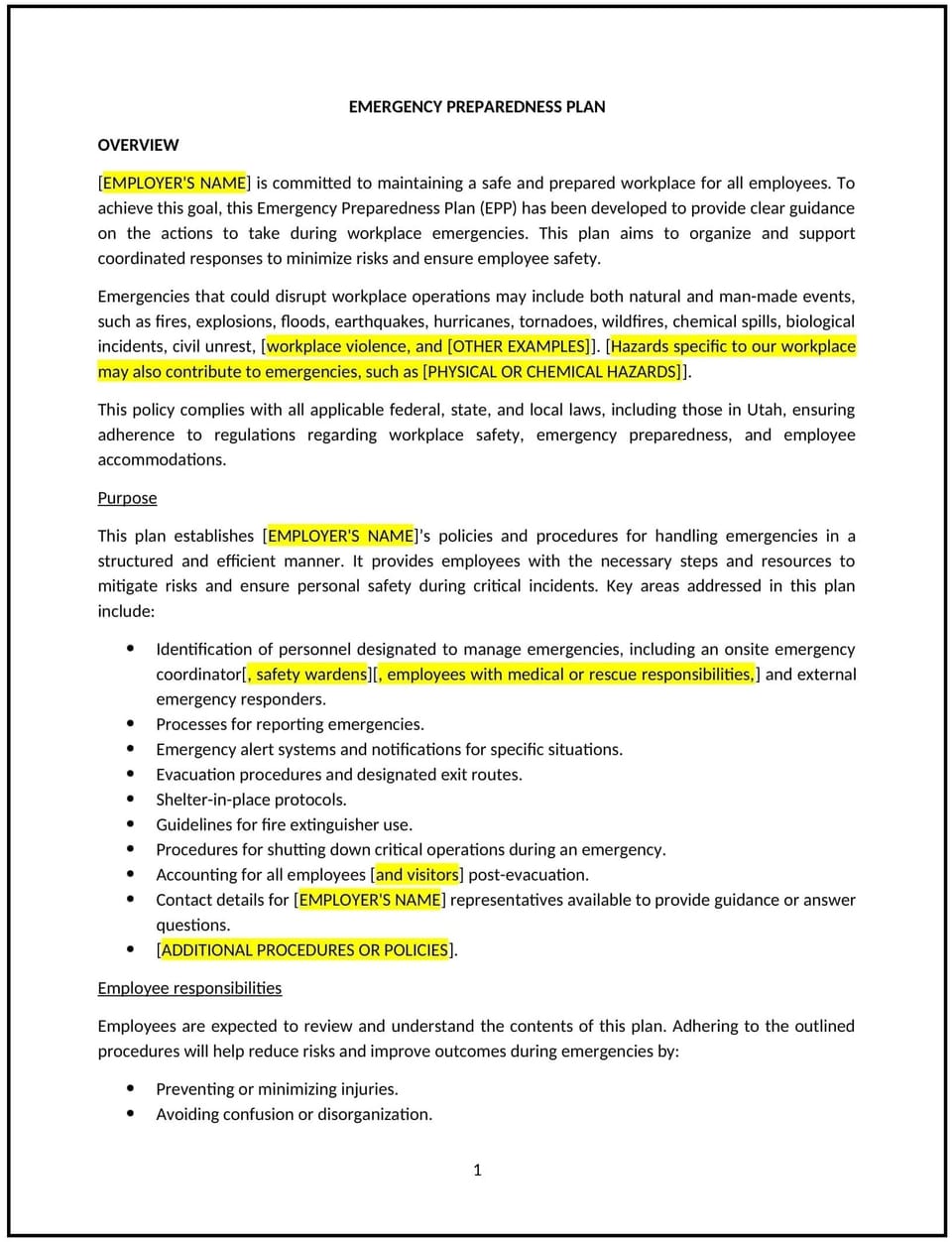Emergency preparedness plan (Utah): Free template

Emergency preparedness plan (Utah)
This emergency preparedness plan is designed to help Utah businesses establish procedures for responding to emergencies, such as natural disasters, fires, or workplace incidents. It outlines steps for evacuation, communication, and recovery to ensure the safety of employees and minimize disruption to operations.
By adopting this plan, businesses can protect employees, reduce risks, and align with general best practices for emergency preparedness.
How to use this emergency preparedness plan (Utah)
- Identify potential emergencies: Assess risks specific to the business, such as earthquakes, floods, or power outages.
- Develop evacuation procedures: Outline clear evacuation routes and assembly points for employees.
- Establish communication protocols: Define how employees will be notified of emergencies and how they can communicate with management.
- Assign roles and responsibilities: Designate employees to lead emergency response efforts, such as evacuation coordinators or first aid responders.
- Provide training: Educate employees on emergency procedures, including evacuation drills and first aid training.
- Maintain emergency supplies: Ensure the availability of first aid kits, flashlights, and other essential supplies.
- Review and update: Regularly assess the plan to ensure it aligns with evolving risks and business needs.
Benefits of using this emergency preparedness plan (Utah)
This plan offers several advantages for Utah businesses:
- Protects employees: Ensures the safety and well-being of employees during emergencies.
- Reduces risks: Minimizes potential damage to property and disruption to operations.
- Aligns with best practices: Provides a structured approach to managing emergencies.
- Enhances preparedness: Helps businesses respond effectively to unexpected events.
- Builds confidence: Demonstrates a commitment to employee safety and business continuity.
Tips for using this emergency preparedness plan (Utah)
- Communicate the plan: Share the plan with employees and include it in the employee handbook.
- Provide training: Educate employees on emergency procedures and conduct regular drills.
- Monitor supplies: Regularly check and replenish emergency supplies.
- Address feedback: Incorporate employee feedback to improve the plan’s effectiveness.
- Update regularly: Assess the plan annually or as needed to ensure it aligns with evolving risks and business needs.
Q: How does this plan benefit businesses?
A: By preparing for emergencies, businesses can protect employees, reduce risks, and ensure business continuity.
Q: What types of emergencies should businesses prepare for?
A: Businesses should prepare for risks specific to their location, such as earthquakes, floods, fires, or power outages.
Q: How can businesses ensure employees know what to do in an emergency?
A: Businesses should provide training, conduct regular drills, and communicate emergency procedures clearly.
Q: What should businesses include in emergency supplies?
A: Essential supplies may include first aid kits, flashlights, batteries, water, and non-perishable food.
Q: How often should businesses review this plan?
A: Businesses should review the plan annually or as needed to ensure it aligns with evolving risks and business needs.
This article contains general legal information and does not contain legal advice. Cobrief is not a law firm or a substitute for an attorney or law firm. The law is complex and changes often. For legal advice, please ask a lawyer.


